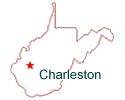Charleston - The State Capital

Located at the confluence of the Elk and Kanawha Rivers, Charleston is the capital city of West Virginia. It is the largest city in West Virginia with a population of around 247,401 (as of 2006). The first permanent settlement in the city was Ft Lee, built in 1788. It was built by Col. Clendenin and his company of Viriginia Rangers. The city was named Charles Town, probably after Col. Clendenin's father, Charles. Later on, the city's named was shortened to Charleston to avoid confusion with another Charles Town in present day West Virginia.
By the 1800's, salt brines were discovered along the banks of the Kanawha River, and the first salt well was drilled in 1806. The discovery of salt in Charleston created a very prosperous time for the city. The city flourished and so did its economy. By 1808, 1250 pounds of salt were being produced a day.
In 1815, while drilling for salt, Captain James Wilson struck the first natural gas well. In 1817, coal was discovered and it became used as the fuel for the salt works. Eventually, the Kanawha salt industry declined after 1861, until World War I. During World War I, a demand for the chemical products of chlorine and caustic acid came about. These chemicals could be made from salt brine, so the salt industry was revived.
Charleston was not always the capital city of West Virginia. For years after the state was founded, the capital of West Virginia floated between Wheeling and Charleston. Finally in 1877, after a vote by the citizens of the state, Charleston was chosen as the capital city.
Now that Charleston was the center of government, it began to grow in size. Natural resources including coal and gas and new industries such as chemical, glass, timber and steel contributed to the city's growth. New construction was booming across the city. A number of these buildings, including churches and office buildings are still standing to this day.
During World War II, the first and largest synthetic rubber plant was built near Charleston, providing its products for the war effort. The construction of this plant blocked Wertz Field's (the airport at the time) approaches, so the airport was closed. In 1947, the Kanawha Airport (now named Yeager Airport) was built. One of the most phenomenal engineering accomplishments of its time, the building required clearing 360 acres of land on three mountaintops, moving more than nine million cubic yards of earth. At that time, the construction of Kanawha Airport was reportedly the second-largest earth-moving project in history, behind the construction of the Panama Canal.




0 Comments:
Post a Comment
Subscribe to Post Comments [Atom]
<< Home